Skin Cancer Diagnostics & Therapeutics Market Size
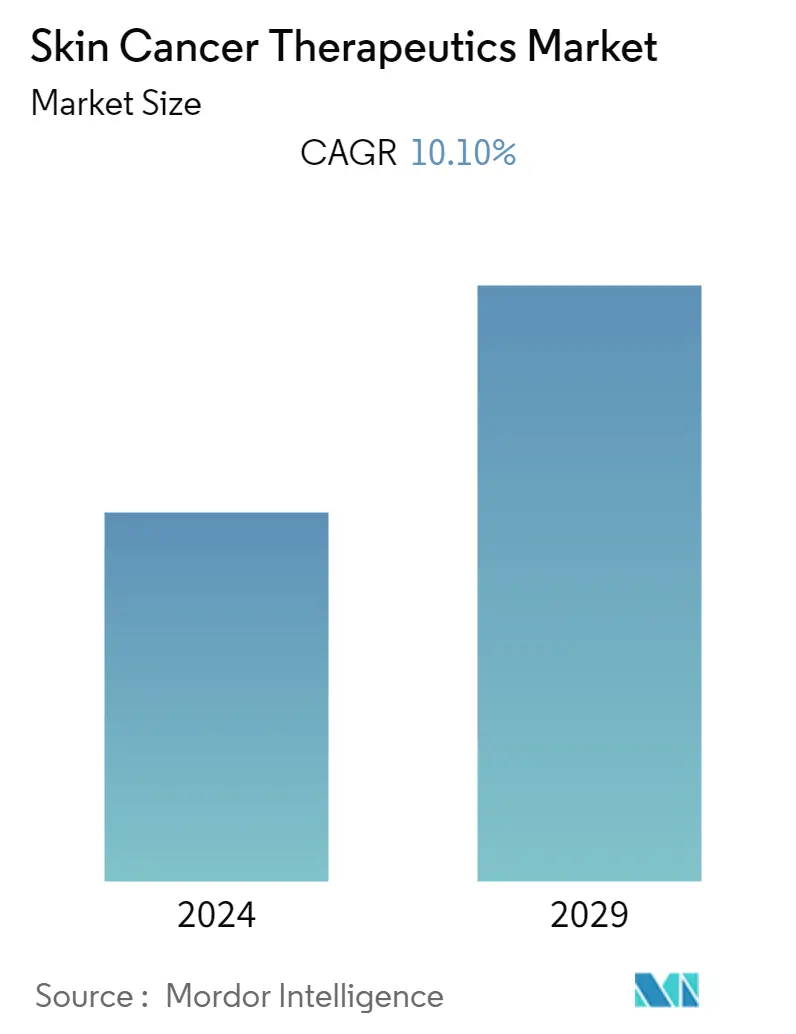
| Study Period | 2021 - 2029 |
| Base Year For Estimation | 2023 |
| Forecast Data Period | 2024 - 2029 |
| CAGR | 10.10 % |
| Fastest Growing Market | Asia Pacific |
| Largest Market | North America |
Major Players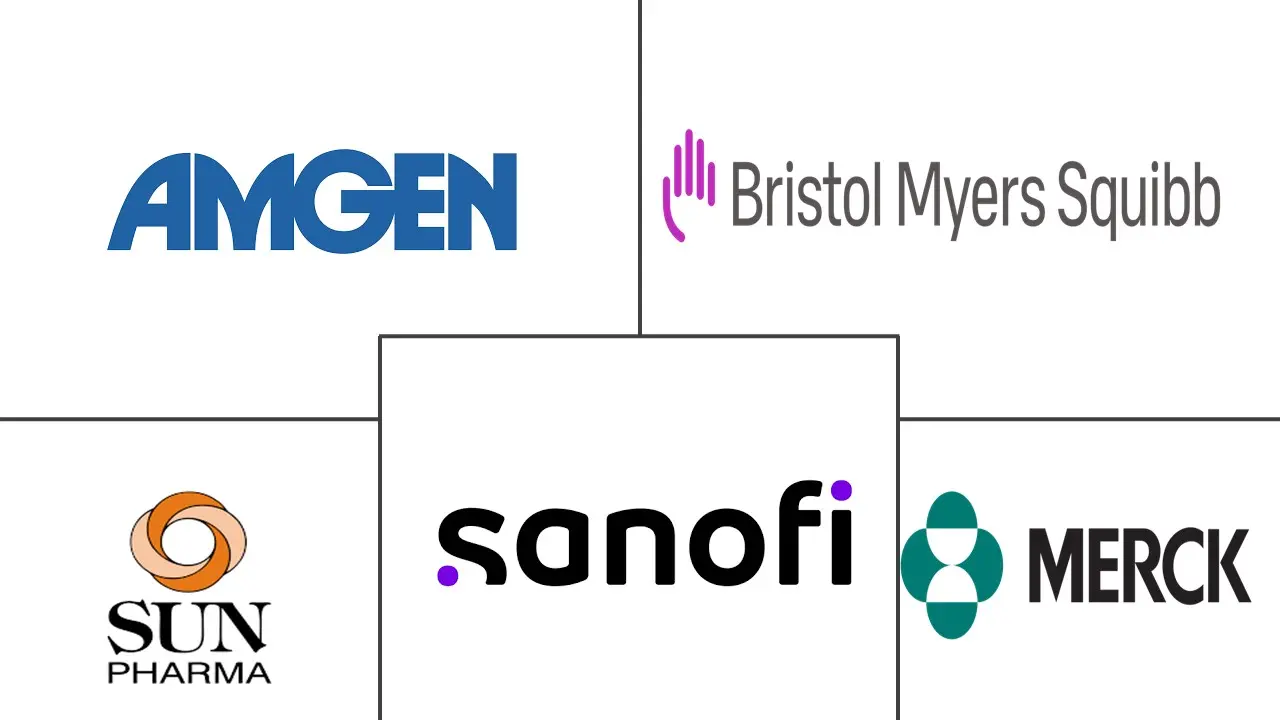
*Disclaimer: Major Players sorted in no particular order |
Skin Cancer Diagnostics & Therapeutics Market Analysis
The Skin Cancer Therapeutics Market is poised to grow at a CAGR of 10.1% over the forecast period.
Covid-19 significantly impacted market growth due to restrictions from hospitals and healthcare settings on nonelective procedures during the pandemic. According to a study published in PLOS ONE in Mach 2021, during the early days of the pandemic, there was a sharp decline in skin biopsies, adversely affecting the elderly, women, and several geographical areas. Even though the number of biopsies increased later, there was still a significant backlog of patients even after six months. The market was also impacted due to the lack of availability of therapeutics because of supply chain restrictions and manufacturing halts. In the later days, the market showed significant improvement due to the rise in the burden of backlog skin biopsies and the availability of skin cancer therapeutics, driving the market growth during the forecast period.
The factors driving the market growth include increasing incidence of skin cancer, rising awareness of skin cancers, and extensive R&D pipelines on skin cancer therapeutics, among others.
Skin cancer is the most common form of cancer. Even though most types of skin cancers are preventable, their incidence is increasing. The risk factors include sunlight, sunlamps and tanning booths, certain medical conditions, or medicines. UV radiation changes the genetic material (DNA) in cells and is, therefore, the main cause of skin cancer. According to the WHO in March 2022, the number of new cases of cutaneous melanoma per year will increase by more than 50% from 2020 to 2040.
Furthermore, increasing supportive initiative by government for rising awareness of skin cancer is also expected to drive market growth. For instance, in May 2021, the American Academy of Dermatology (AAD) launched the SPOT Skin Cancer awareness program. The goal of this awareness program is to raise awareness that helps to prevent skin cancer, find this disease early, and save lives. Such initiatives will help inform people of skin cancer treatments, driving market growth.
In addition, the rising drug approvals of innovative skin cancer therapeutics from international regulatory agencies are expected to bolster market growth over the forecast period. For instance, in February 2021, the US FDA approved the PD-1 inhibitor Libtayo (cemiplimab-rwlc) as the first immunotherapy indicated for patients with advanced basal cell carcinoma (BCC). However, the high cost associated with the therapy and the side effects and complications associated with treatment may be expected to hinder market growth.
Skin Cancer Diagnostics & Therapeutics Market Trends
This section covers the major market trends shaping the Skin Cancer Diagnostics & Therapeutics Market according to our research experts:
Non-melanoma Skin Cancer Segment is Expected to Witness Healthy Growth in the Future
Non-melanoma skin cancer (NMSC) refers to the abnormal growth of malignant cells in the upper layer of the skin. Some of the common types of NMSC include basal cell, Merkle cell and squamous cell carcinoma, and cutaneous T-cell lymphoma. It is primarily characterized by the development of firm lumps or scaly patches on the skin. The treatment methodologies involve the removal of cancer cells through surgical procedures, including micrographic surgery, laser therapy, cryotherapy, and various non-surgical treatments, such as photodynamic therapy (PDT), radiotherapy, and electrotherapy.
According to the American Cancer Society in January 2022, non-melanoma cancers are by far the most common of all types of cancer and it was estimated that about 5.4 million basal and squamous cell skin cancers are diagnosed each year in the United States (occurring in about 3.3 million Americans, as some people have more than one). Furthermore, according to the same source, 80% of these are basal cell cancers (a type of non-melanoma cancer). Therefore, such a huge incidence of non-melanoma cancer is anticipated to drive segment growth due to the rise in the demand for therapeutics for non-melanoma skin cancers.
Moreover, the rising initiatives from market players such as the expansion of the R&D pipelines for non-melanoma therapeutics are expected to drive the segment growth over the forecast period. For instance, in February 2021, MediWound Ltd. an Israeli biopharma company initiated a new clinical development program to evaluate its drug product candidate MWPC005 in patients with non-melanoma skin cancer. Thus, positive outcomes of such studied will lead to new therapeutic options, thereby raising segmental growth.
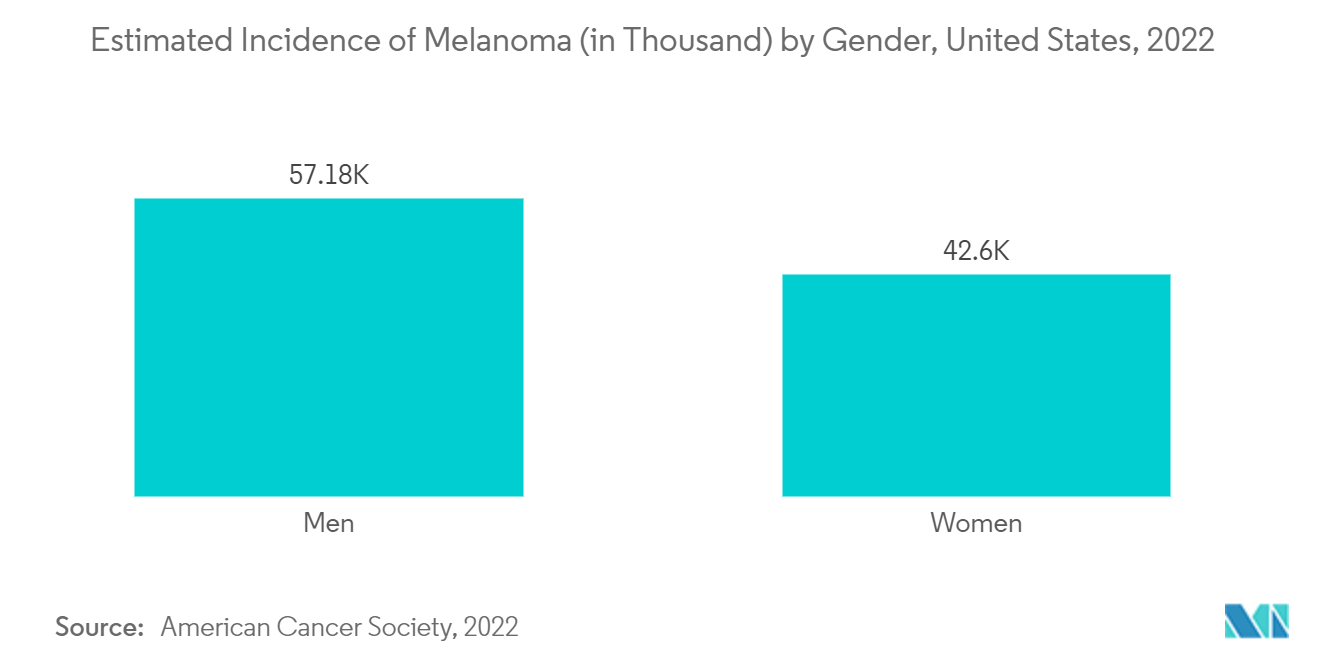
North America Holds a Significant Market Share and is Expected to do so in the Forecast Period
North America is expected to have a significant share in the market owing to factors such as the rising prevalence of skin cancers, the strong foothold of key market players, and improved healthcare infrastructure.
As per the American Academy of Dermatology Association in 2022, skin cancer was the most common cancer in the United States. It is estimated that 197,700 new cases of melanoma (including 97,920 noninvasive (in situ) and 99,780 invasives) were diagnosed in the United States in 2022. In addition, according to a study published by McGill University Canada in June 2022, the prevalence of melanoma was rising in Canada. These developments in the United States and Canada are expected to drive market growth in the region.
Additionally, key market players' recent advancements in skin cancer therapy for developing innovative therapies and rising approvals of such therapies are boosting the growth of the market studied during the forecast period. For instance, in March 2022, the US FDA approved nivolumab and relatlimab-rmbw (Opdualag, Bristol-Myers Squibb Company) for adult and pediatric patients 12 years of age or older with unresectable or metastatic melanoma. Rising approvals of innovative immunotherapies are likely to drive market growth in the future.
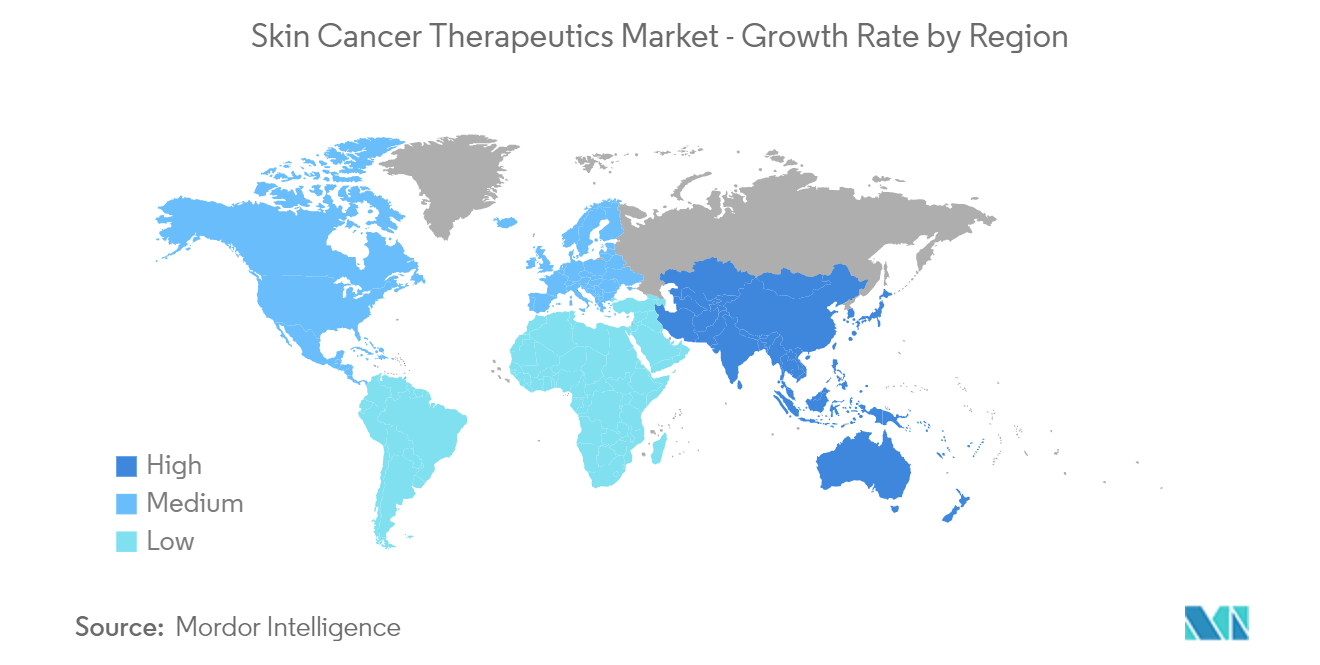
Skin Cancer Diagnostics & Therapeutics Industry Overview
The global skin cancer therapeutics market is highly competitive and consists of several major players. The competition in the market is due to factors such as rising launches and approvals of skin cancer therapeutics and increased R&D for developing novel skin cancer therapeutics. Some of the companies operating in the market include Amgen, Inc., Bristol-Myers Squibb Company, Merck & Co., Inc., Sun Pharmaceutical Industries Ltd, Regeneron Pharmaceuticals Inc, and Sanofi SA, among others,
Skin Cancer Diagnostics & Therapeutics Market Leaders
-
Amgen Inc.
-
Bristol-Myers Squibb Company
-
Merck & Co., Inc.
-
Sun Pharmaceutical Industries Ltd.
-
Sanofi SA
*Disclaimer: Major Players sorted in no particular order
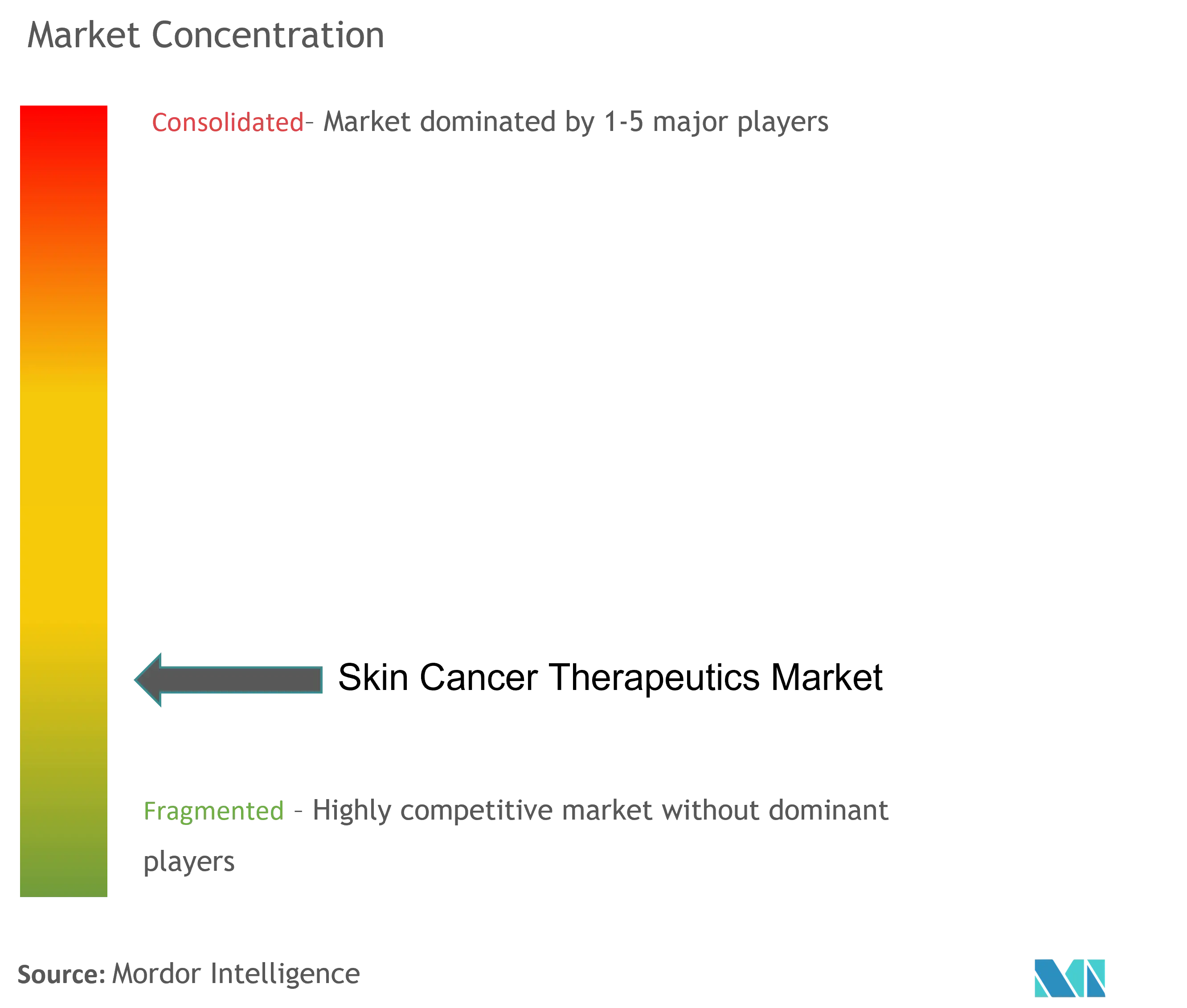
Skin Cancer Diagnostics & Therapeutics Market News
- In December 2022, Sirnaomics Ltd. released the interim results of part one of an ongoing Phase IIb clinical trial of STP705 for the treatment of Cutaneous Squamous Cell Carcinoma In Situ (isSCC). The compound showed positive clinical readouts of the part-one study of this Phase IIb trial.
- In April 2022, Regeneron Pharmaceuticals, Inc. and Checkmate Pharmaceuticals, Inc. entered a definitive agreement to acquire Checkmate by Regeneron. With this acquisition, Regeneron seeks to develop the lead candidate Vidutolimod, which is currently being studied in combination with other agents for melanoma, non-melanoma skin cancers, and head and neck cancer.
Skin Cancer Diagnostics & Therapeutics Market Report - Table of Contents
1. INTRODUCTION
- 1.1 Study Assumptions and Market Definition
- 1.2 Scope of the Study
2. RESEARCH METHODOLOGY
3. EXECUTIVE SUMMARY
4. MARKET DYNAMICS
- 4.1 Market Overview
-
4.2 Market Drivers
- 4.2.1 Increasing Incidence of Skin Cancer
- 4.2.2 Rising Awareness about Skin Cancer
- 4.2.3 Extensive R&D Pipelines
-
4.3 Market Restraints
- 4.3.1 High Cost Associated with Therapy
-
4.4 Porter's Five Forces Analysis
- 4.4.1 Threat of New Entrants
- 4.4.2 Bargaining Power of Buyers/Consumers
- 4.4.3 Bargaining Power of Suppliers
- 4.4.4 Threat of Substitute Products
- 4.4.5 Intensity of Competitive Rivalry
5. MARKET SEGMENTATION
-
5.1 By Disease Type
- 5.1.1 Melanoma
- 5.1.2 Non-melanoma
-
5.2 By Treatment
- 5.2.1 Chemotherapy
- 5.2.2 Immunotherapy
- 5.2.3 Targeted Therapy
- 5.2.4 Others
-
5.3 Geography
- 5.3.1 North America
- 5.3.1.1 United States
- 5.3.1.2 Canada
- 5.3.1.3 Mexico
- 5.3.2 Europe
- 5.3.2.1 Germany
- 5.3.2.2 United Kingdom
- 5.3.2.3 France
- 5.3.2.4 Italy
- 5.3.2.5 Spain
- 5.3.2.6 Rest of Europe
- 5.3.3 Asia-Pacific
- 5.3.3.1 China
- 5.3.3.2 Japan
- 5.3.3.3 India
- 5.3.3.4 Australia
- 5.3.3.5 South Korea
- 5.3.3.6 Rest of Asia-Pacific
- 5.3.4 Middle-East and Africa
- 5.3.4.1 GCC
- 5.3.4.2 South Africa
- 5.3.4.3 Rest of Middle-East and Africa
- 5.3.5 South America
- 5.3.5.1 Brazil
- 5.3.5.2 Argentina
- 5.3.5.3 Rest of South America
6. COMPETITIVE LANDSCAPE
-
6.1 Company Profiles
- 6.1.1 Amgen, Inc.
- 6.1.2 Pfizer Inc.
- 6.1.3 Bristol-Myers Squibb Company
- 6.1.4 IOVANCE Biotherapeutics, Inc.
- 6.1.5 Sanofi SA
- 6.1.6 Merck & Co., Inc.
- 6.1.7 Novartis AG
- 6.1.8 Regeneron Pharmaceuticals Inc
- 6.1.9 Sun Pharmaceutical Industries Ltd.
- 6.1.10 EVAXION BIOTECH A/S
- 6.1.11 InxMed
- 6.1.12 MediWound Ltd
- *List Not Exhaustive
7. MARKET OPPORTUNITIES AND FUTURE TRENDS
** Subject To AvailablitySkin Cancer Diagnostics & Therapeutics Industry Segmentation
Skin cancer is the abnormal development of skin cells that typically manifests on skin that has been exposed to the sun. However, this prevalent type of cancer can also develop on parts of your skin that are not often exposed to sunlight. Ultraviolet radiation is a primary carcinogen that results in UV-induced mutations, loss of activity in tumor suppressor genes, and the overexpression of oncogenes in keratinocytes.
The Skin Cancer Therapeutics Market is segmented by Disease Type (Melanoma, and Non-melanoma), Treatment (Chemotherapy, Immunotherapy, Targeted therapy, Others), and Geography (North America, Europe, Asia-Pacific, Middle East and Africa, and South America). The market report also covers the estimated market sizes and trends for 17 different countries across major regions globally. The report offers the value (in USD million) for the above segments.
| By Disease Type | Melanoma | |
| Non-melanoma | ||
| By Treatment | Chemotherapy | |
| Immunotherapy | ||
| Targeted Therapy | ||
| Others | ||
| Geography | North America | United States |
| Canada | ||
| Mexico | ||
| Geography | Europe | Germany |
| United Kingdom | ||
| France | ||
| Italy | ||
| Spain | ||
| Rest of Europe | ||
| Geography | Asia-Pacific | China |
| Japan | ||
| India | ||
| Australia | ||
| South Korea | ||
| Rest of Asia-Pacific | ||
| Geography | Middle-East and Africa | GCC |
| South Africa | ||
| Rest of Middle-East and Africa | ||
| Geography | South America | Brazil |
| Argentina | ||
| Rest of South America |
Skin Cancer Diagnostics & Therapeutics Market Research FAQs
What is the current Skin Cancer Therapeutics Market size?
The Skin Cancer Therapeutics Market is projected to register a CAGR of 10.10% during the forecast period (2024-2029)
Who are the key players in Skin Cancer Therapeutics Market?
Amgen Inc., Bristol-Myers Squibb Company, Merck & Co., Inc., Sun Pharmaceutical Industries Ltd. and Sanofi SA are the major companies operating in the Skin Cancer Therapeutics Market.
Which is the fastest growing region in Skin Cancer Therapeutics Market?
Asia Pacific is estimated to grow at the highest CAGR over the forecast period (2024-2029).
Which region has the biggest share in Skin Cancer Therapeutics Market?
In 2024, the North America accounts for the largest market share in Skin Cancer Therapeutics Market.
What years does this Skin Cancer Therapeutics Market cover?
The report covers the Skin Cancer Therapeutics Market historical market size for years: 2021, 2022 and 2023. The report also forecasts the Skin Cancer Therapeutics Market size for years: 2024, 2025, 2026, 2027, 2028 and 2029.
Skin Cancer Therapeutics Industry Report
Statistics for the 2024 Skin Cancer Therapeutics market share, size and revenue growth rate, created by Mordor Intelligence™ Industry Reports. Skin Cancer Therapeutics analysis includes a market forecast outlook to 2029 and historical overview. Get a sample of this industry analysis as a free report PDF download.



